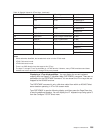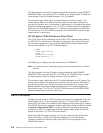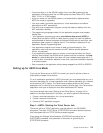v You cannot sign on to the AS/400 system from a non-IBM system and use
workstation functions unless the non-IBM system provides Telnet 3270, Telnet
5250, VT100, or VT220 support.
v A sign-on screen for the AS/400 system is not automatically displayed when
ASCII line mode is negotiated.
v You must create a controller description for virtual workstations and device
descriptions for NVT workstations.
v You must have an application program running that opens a display file to the
NVT workstation devices.
v The programming language chosen for the application program must support
display files.
v Your application program must use a user-defined data stream (UDDS) to
interact with the device. UDDS is a data stream in which the user has defined
and embedded all device characters and allows AS/400 users to send their own
workstation data stream to a display device. This interface is described in the
Application Display Programming
book.
v Your application program must format all data and provide security. Your
application code must control access to the NVT device (provide password
control, for example).
v If your application program does not acquire a virtual device before the Telnet
inactivity timer expires, the AS/400 server system ends the connection. A virtual
device is a device description that does not have hardware associated with it. It
is used to form a connection between a user and a physical workstation attached
to a remote system.
v Data is passed to the application without being mapped from ASCII to EBCDIC.
Setting up for ASCII Line Mode
To set up the Telnet server for ASCII line mode, you need to set the number of
automatically created virtual devices.
To run a workstation application in ASCII line mode, you must create and vary on a
controller description for a virtual workstation and a device description for a network
virtual terminal (NVT) display. The Telnet server support selects an NVT device
description that is varied on and not being used by another user. Your Telnet server
application must open a display file that uses the selected NVT device.
You should already have read “Setting Up the Telnet Server” on page 183. In
addition to the steps discussed in that topic, you need to perform the following:
1. Create a controller description for a virtual workstation.
2. Create a network virtual device.
3. Create an NVT application program.
Step 1—ASCII—Starting the Telnet Server Job
The server job for a TCP/IP application must be started in the QSYSWRK
subsystem. The Start TCP/IP Server (STRTCPSVR) command starts the servers
that are shipped with the TCP/IP Utilities licensed program.
Even though the Change Telnet Attributes (CHGTELNA) command has an
AUTOSTART parameter, that parameter is overridden or ignored by the
STRTCPSVR command.
Chapter 6. Telnet Server 211


















